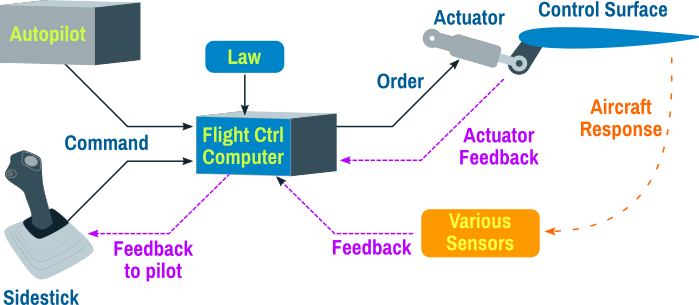Fly-By-Wire - An Essay
06 Apr 2018Fly-By-Wire The Development of Digital Flight Control Computer Systems

This past century has seen remarkable advancements in aviation technology and as the complexity of aircraft increased, so did the difficulty of managing the various systems that make up the aircraft. To handle all the new intricate aircraft technologies, human pilots alone were no longer enough and thus, automatic piloting systems were created. These systems initially functioned with mechanical components, but eventually, more sophisticated embedded computer systems technology made its way onboard, providing drastic improvements. An embedded computer system is defined as a computer system built for a specific application; this means that it is more specialized than devices such as laptops, and even smartphones, which are designed for general purpose computing. Not only did electronic computers make it possible to operate increasingly complex flying machines with high accuracy, they also improved safety and greatly reduced the amount of weight the aircraft had to bear when all the control systems were comprised of mechanical and hydraulic parts. This new type of technology became known as the fly-by-wire system and since its invention, further developed to become a system that is heavily relied upon by flight crews today. “Fly-by-wire technology translates the pilot’s actions into electronic signals, which computers use to manipulate flight controls. The computers constantly monitor pilot input and prevent the aircraft from exceeding its flight envelope, thereby increasing safety. And because fly-by-wire replaces heavy, complex mechanical linkages with light electrical wires, it is more efficient.” (“The Computer Revolution in the Cockpit”, 2007). The initial development of electricbased flight control technology occurred in the 1930s. This was just over a decade before the very first digital electronic computer was invented; and once the first digital flight control computer system was implemented, it would prove itself to be a significant development in the history of both aviation and spaceflight.
In the early 1900s, the world witnessed the very first application of flight control systems that extended beyond mere human operation. This system became known as the autopilot control system for aircraft and was invented in 1912 by Lawrence Sperry. “Sperry hit upon the idea that if the three flight axes of an aircraft – yaw, pitch, and roll – could be harnessed to the stability of a gyroscope, an automatic control system might be developed… The guidance device would perform mechanically what the pilot performed instinctively.” Scheck (2017). This system improved the controllability of aircraft, but its mechanical design left much to be improved upon. Massive improvements in aircraft controllability would eventually be made possible with electrical designs. Electrical systems were first brought onboard aircraft to replace the mechanical and hydraulic designs when the Soviet Tupolev ANT-20 was developed in the 1930s; the ANT-20 used servo-electrically operated control systems. Since this aircraft’s control systems were servoelectrically operated, they still contained some mechanical components. The opportunity for developing purely electronic flight control systems would come shortly after the invention of the digital electronic computer. During the Second World War, a British mathematician and logician named Alan Turing was tasked with creating a code-breaking machine to be used against the Germans. His success in creating this machine helped the Allies win the war and it also created a basis for a new kind of technology: the digital electronic computer. After WWII, work on computational machines continued and the Royal Society Computing Machine Laboratory at the University of Manchester successfully built the first digital electronic computer in June 1948. After this accomplishment, the advancement of computer technology continued at breakneck speeds. As computational power increased, the size of the hardware shrunk; and in the late 1950s, the technology had already become compact and light enough to be considered for use in flying machines. This spurred the creation of the NASA Digital Fly-By-Wire Development Program that operated with the goal of creating a digital electronic computer flight control system for use in aviation and space flight. This development program would be responsible for the very first applications of purely electronic aircraft control systems. In 1964, the first fully-electric aircraft took flight. This aircraft was the Apollo Lunar Landing Research Vehicle, which was constructed to train astronauts for landing on the moon; it used an analog control system and did not incorporate any kind of mechanical backup system. The technology was developed further and on May 25, 1972, the first flight to successfully demonstrate a digital computer’s ability to operate an aircraft took place at NASA’s Dryden Flight Research Center. “NASA research pilot Gary Krier became the first to fly a digital fly-by-wire aircraft when he piloted NASA’s highly modified F-8C Crusader jet fighter.” (“The Computer Revolution in the Cockpit”, 2007). The F-8C aircraft was controlled using a digital electronic computer that had three analog redundant channels to prevent loss of control if the digital system were to fail. NASA continued developing fly-by-wire; using it to operate more aerospace vehicles such as the space shuttle, but the technology would not be fully incorporated in the civilian field of aviation until the 1980s with the introduction of the Airbus A320.
The Airbus A320’s development started in 1984 and it became the first commercial airliner to fly using digital fly-by-wire control systems. Its first flight occurred on February 22, 1987 and it was delivered to Air France a year later to be put into commercial operation. This paved the way for an increasingly safe and economically efficient form of commercial air transportation that is heavily relied upon in today’s world. Digital fly-by-wire systems improved economic efficiency with their low weight compared to the previous mechanical control systems, but that was not all. In addition, they have lower maintenance demands; mostly due to the absence of moving parts, and they also provide extremely tight control over the engines of the aircraft for maximum performance. The improved efficiency of digital fly-by-wire airliners permits them to transport more passengers and cargo than the amount that would have been possible without the technology. The experience of riding in an airliner was also made to be as smooth as ever because of the increased maneuverability thanks to the digital computer system’s frequent control adjustments; made far more rapidly than what is humanly possible.
The development of fly-by-wire technology was met with many challenges. To successfully operate an aircraft, the embedded computer systems need to be able to constantly receive data in real-time through inputs provided by both the pilots and various sensors such as altimeters and pitot tubes, which measure altitude and airspeed respectively. Once that data is received, it needs to be processed accurately and in a timely manner to produce the appropriate outputs that operate the aircraft. Moreover, some of the processes need to take place simultaneously and others need to occur at different rates, further increasing the complexity of the system. The computer systems also need to function properly in the harsh environment created by powered flight. “Many embedded systems do not operate in a controlled environment. Excessive heat is often a problem, especially in applications involving combustion. Additional problems can be caused for embedded computing by a need for protection from vibration, shock, lightning, power supply fluctuations, water, corrosion, fire, and general physical abuse.” Koopman (1996). The computer systems need to be designed to be both rugged and reasonably lightweight; although, reducing the weight of flyby-wire systems did not need to be a focus in its early development because electrical systems could easily be lighter than the mechanical systems that perform similar functions.
Safety and reliability are also incredibly important factors that presented fly-by-wire aircraft development with additional design challenges. “Some systems have obvious risks associated with failure. In mission-critical applications such as aircraft flight control, severe personal injury or equipment damage could result from failure of the embedded computer. Traditionally, such systems have employed multiply-redundant computers or distributed consensus protocols in order to ensure continued operation after an equipment failure.” Koopman (1996). When aircraft used mechanical and hydraulic systems for flight control, a failure was usually a gradual process; however, when an electrical computer system fails, it happens immediately. To prevent the fly-bywire aircraft from becoming instantly uncontrollable in the event of a computer failure, multiple redundant computers and sometimes backup mechanical systems were included in the system’s design. This redundancy didn’t just provide an answer to safe and reliable fly-by-wire systems; it also surpassed the level of safety and reliability offered by purely mechanical aircraft systems, which were too bulky to have additional backup systems incorporated into their design. Another way to lessen the risk of flight control system failure during flight is to conduct pre-flight safety checks. Today, these are often done with built-in test equipment that speeds up the process.
The challenges that confronted the scientist and engineers who worked on developing digital flyby-wire control systems were difficult to overcome, but their success in this endeavor proved itself to be well worth the effort. Today, the applications of this technology have extended to all aspects of military, government, and civil aviation. Digital electronic flight control systems can now operate aircraft with more precision than even the most skillful pilots and with additional artificial intelligence (A.I.) programming, the control systems are able to “learn” during flight. This will increase the chances of recovering from various situations that lead to accidents in aviation, such as flight characteristics of an aircraft changing due to component damage or failures. The embedded computer systems utilizing A.I. technology will still be able to assist the pilot in controlling the damaged aircraft because they can learn the new flight characteristics in a very short amount of time and adjust the controls accordingly. This application of the technology is called the Intelligent Flight Control System (IFCS) and is currently being developed at the NASA Dryden Flight Research Center; the same place where the first fly-by-wire technology was developed. “Major control surface or airframe damage hinders an aircraft flight control system’s design integrity, rendering traditional fixed control systems virtually worthless. The IFCS team has integrated innovative neural network technologies with state-of-the-art control algorithms to correctly identify and respond to changes in aircraft stability and control characteristics, and immediately adjust to maintain the best possible flight performance during an unexpected failure.” Gibbs (2017). Fly-by-wire technologies in today’s world have also evolved into various other new developments such as fly-by-optics, power-by-wire, and fly-by-wireless; each further enhancing the field of aviation. Fly-by-optics improves the rate at which data flows through the embedded computer systems; power-by-wire provides aircraft with backup power if hydraulic power is lost, and flyby-wireless makes aircraft lighter by removing electrical components from the aircraft and placing them elsewhere. Aviation is now safer and more efficient than ever due to the increased complexity of the technologies that make up today’s aircraft. This level of complexity aircraft have achieved would have been impossible without the development of fly-by-wire digital flight control computer systems. Aircraft flight control computer systems will continue to get smarter, lighter, and more efficient; this ensures that aircraft technology will further advance, providing the field of aviation with a bright future.
 Grant Novota
Grant Novota